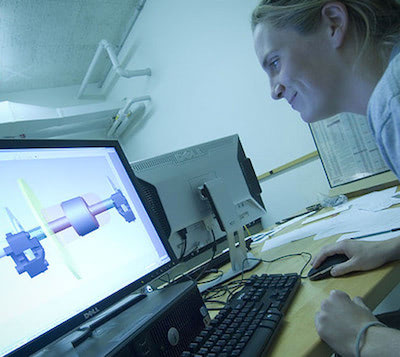- Undergraduate
Bachelor's Degrees
Bachelor of ArtsBachelor of EngineeringDual-Degree ProgramUndergraduate AdmissionsUndergraduate Experience
- Graduate
Graduate Experience
- Research
- Entrepreneurship
- Community
- About
-
Search
All Thayer News
Dartmouth Expands Use of SOLIDWORKS Applications for Innovative Engineering Education
Sep 15, 2014 | Dassault Systèmes
SOLIDWORKS Applications Now Used by Engineering Students in Nine Courses at All Levels; Integral to Problem-based Experiential Learning
Dassault Systèmes, the 3DEXPERIENCE Company, world leader in 3D design software, 3D Digital Mock Up and Product Lifecycle Management (PLM) solutions, today announced that the Thayer School of Engineering at Dartmouth has expanded its implementation of SOLIDWORKS. Powered by the 3DEXPERIENCE platform, the application is now introduced to all engineering majors as part of the core curriculum in the school. The expansion is an integral part of recent enhancements made to the school’s innovative engineering programs, integrating SOLIDWORKS into more courses and research programs at all levels each year. One of America’s oldest professional schools of engineering, Dartmouth's Thayer School has a long history of educating innovators who use their engineering talent to solve important problems. To achieve the college’s educational objectives, professors strive to integrate a sense of curiosity, technical skill development and practical learning to channel the students’ passion for engineering in ways that make it fun, productive and rewarding. An important prerequisite to this approach is design software that is easy to learn and use, which led Thayer School to standardize on SOLIDWORKS five years ago.
“As educators, it’s our responsibility to attract, train and retain the engineers of tomorrow,” said Solomon G. Diamond, Ph.D., Associate Professor of Engineering at Dartmouth. “It’s important to provide an environment that is fun and exciting, and design tools that facilitate problem-based experiential learning. SOLIDWORKS is a vital part of our students’ learning experience. Because of our approach, students don’t have much time to be trained on design software, so the short learning curve of SOLIDWORKS is critical for students to undergo an innovation process that’s similar to industry.”

Students in Thayer's Computer-Aided Design Lab use SOLIDWORKS and other design software to create precise drawings of their project components.
For students, use of SOLIDWORKS applications starts during freshman or sophomore year in the school’s Introduction to Engineering course, which is open to all students whether they are engineering majors or not. Students are introduced to engineering through participation, as a member of a team, in real-world engineering problem solving. Engineering principles of analysis, experimentation and design are applied to a real problem that the students identify and study in the field, then propose solutions, build prototypes, test and refine their solution, and present final recommendations to a panel of faculty. Students not only consider technical aspects but also must examine the social, ethical, financial, and business aspects of implementing their solution.
“We’re extremely proud of our long-standing partnership with Dr. Diamond and the Thayer School of Engineering at Dartmouth,” said Philippe Forestier, Executive Vice President, Global Affairs, Dassault Systèmes. “Specifically, it’s a shining example of how SOLIDWORKS applications have been implemented to change engineering education. It’s wonderful to see not only what the students design and manufacture, but also the success they achieve as a result of Thayer’s programs. With over 30 percent female student enrollment, the Thayer School is setting the bar in another important area as well.”
SOLIDWORKS applications are also helping Dr. Diamond and his doctoral students conduct breakthrough research in Dartmouth’s Multimodal Neuroimaging Laboratory. As part of the college’s innovative research into brain disorders, graduate students used SOLIDWORKS to create a magnetically shielded room for noninvasive studies of human brain function in the lab. The shielded room is necessary for measuring the minute magnetic fields that come from neural activity in the brain. The biomagnetic fields are monitored simultaneously with noninvasive measurements of cerebral blood oxygen levels, using near-infrared light to provide assessments of neurovascular physiology.
Link to source:
For contacts and other media information visit our Media Resources page.
